Strategic Planning Theory and Practice in Policing: A Critical Review
VerifiedAdded on 2023/04/05
|13
|2990
|132
Essay
AI Summary
This essay critically discusses strategic planning theory and its application within the policing and emergency services sector, particularly focusing on the South Australian Police (SAPOL). It begins by identifying key external factors influencing SAPOL through a PEST analysis, highlighting the significance of political, legal, economic, social, and technological factors. The essay then analyzes SAPOL's strategic planning process, evaluating aspects such as input accumulation, vision statement creation, mission design, and risk/strategy determination, comparing them against established strategic planning theories. Gaps are identified, such as the lack of a comparison mechanism between internal and external factors, and recommendations are made to align internal policies with external changes to enhance the department's adaptability and effectiveness. The essay concludes by emphasizing the importance of considering both internal values and external factors in strategic planning for long-term sustainability and improved service delivery.

Running head: STRATEGIC MANAGEMENT
Strategic management
Name of the student
Name of the university
Author note
Strategic management
Name of the student
Name of the university
Author note
Secure Best Marks with AI Grader
Need help grading? Try our AI Grader for instant feedback on your assignments.

1STRATEGIC MANAGEMENT
Table of Contents
Introduction......................................................................................................................................2
Identification of the external factors................................................................................................3
Political and legal factors.............................................................................................................3
Economical factors......................................................................................................................3
Social factors...............................................................................................................................4
Technological factors...................................................................................................................5
Analysis of the strategic planning process of SAPOL.....................................................................5
Accumulation of inputs................................................................................................................5
Creating vision statement............................................................................................................6
Creating mission designs.............................................................................................................7
Determination of the risks, strategies and tactics........................................................................8
Conclusion.......................................................................................................................................9
Reference.......................................................................................................................................11
Table of Contents
Introduction......................................................................................................................................2
Identification of the external factors................................................................................................3
Political and legal factors.............................................................................................................3
Economical factors......................................................................................................................3
Social factors...............................................................................................................................4
Technological factors...................................................................................................................5
Analysis of the strategic planning process of SAPOL.....................................................................5
Accumulation of inputs................................................................................................................5
Creating vision statement............................................................................................................6
Creating mission designs.............................................................................................................7
Determination of the risks, strategies and tactics........................................................................8
Conclusion.......................................................................................................................................9
Reference.......................................................................................................................................11
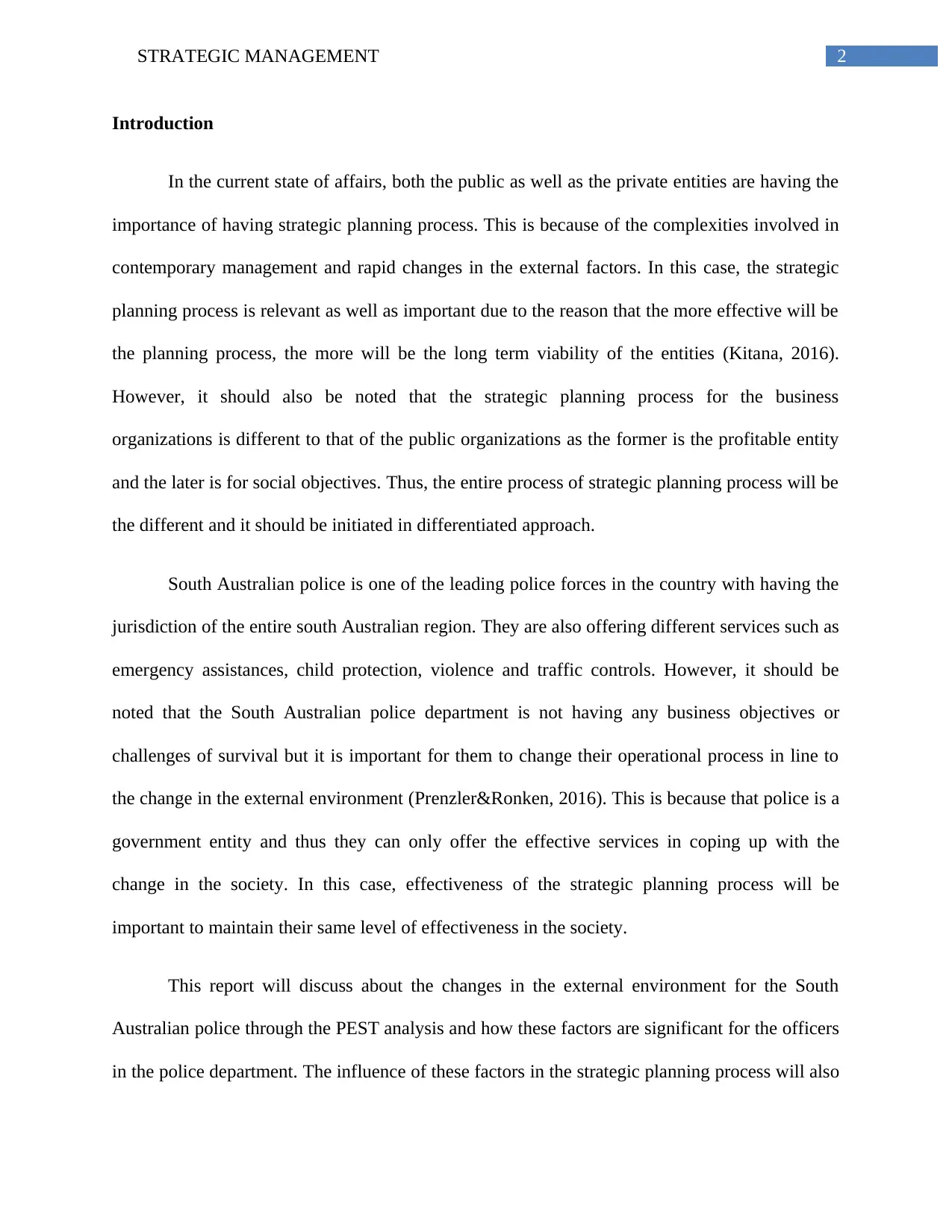
2STRATEGIC MANAGEMENT
Introduction
In the current state of affairs, both the public as well as the private entities are having the
importance of having strategic planning process. This is because of the complexities involved in
contemporary management and rapid changes in the external factors. In this case, the strategic
planning process is relevant as well as important due to the reason that the more effective will be
the planning process, the more will be the long term viability of the entities (Kitana, 2016).
However, it should also be noted that the strategic planning process for the business
organizations is different to that of the public organizations as the former is the profitable entity
and the later is for social objectives. Thus, the entire process of strategic planning process will be
the different and it should be initiated in differentiated approach.
South Australian police is one of the leading police forces in the country with having the
jurisdiction of the entire south Australian region. They are also offering different services such as
emergency assistances, child protection, violence and traffic controls. However, it should be
noted that the South Australian police department is not having any business objectives or
challenges of survival but it is important for them to change their operational process in line to
the change in the external environment (Prenzler&Ronken, 2016). This is because that police is a
government entity and thus they can only offer the effective services in coping up with the
change in the society. In this case, effectiveness of the strategic planning process will be
important to maintain their same level of effectiveness in the society.
This report will discuss about the changes in the external environment for the South
Australian police through the PEST analysis and how these factors are significant for the officers
in the police department. The influence of these factors in the strategic planning process will also
Introduction
In the current state of affairs, both the public as well as the private entities are having the
importance of having strategic planning process. This is because of the complexities involved in
contemporary management and rapid changes in the external factors. In this case, the strategic
planning process is relevant as well as important due to the reason that the more effective will be
the planning process, the more will be the long term viability of the entities (Kitana, 2016).
However, it should also be noted that the strategic planning process for the business
organizations is different to that of the public organizations as the former is the profitable entity
and the later is for social objectives. Thus, the entire process of strategic planning process will be
the different and it should be initiated in differentiated approach.
South Australian police is one of the leading police forces in the country with having the
jurisdiction of the entire south Australian region. They are also offering different services such as
emergency assistances, child protection, violence and traffic controls. However, it should be
noted that the South Australian police department is not having any business objectives or
challenges of survival but it is important for them to change their operational process in line to
the change in the external environment (Prenzler&Ronken, 2016). This is because that police is a
government entity and thus they can only offer the effective services in coping up with the
change in the society. In this case, effectiveness of the strategic planning process will be
important to maintain their same level of effectiveness in the society.
This report will discuss about the changes in the external environment for the South
Australian police through the PEST analysis and how these factors are significant for the officers
in the police department. The influence of these factors in the strategic planning process will also
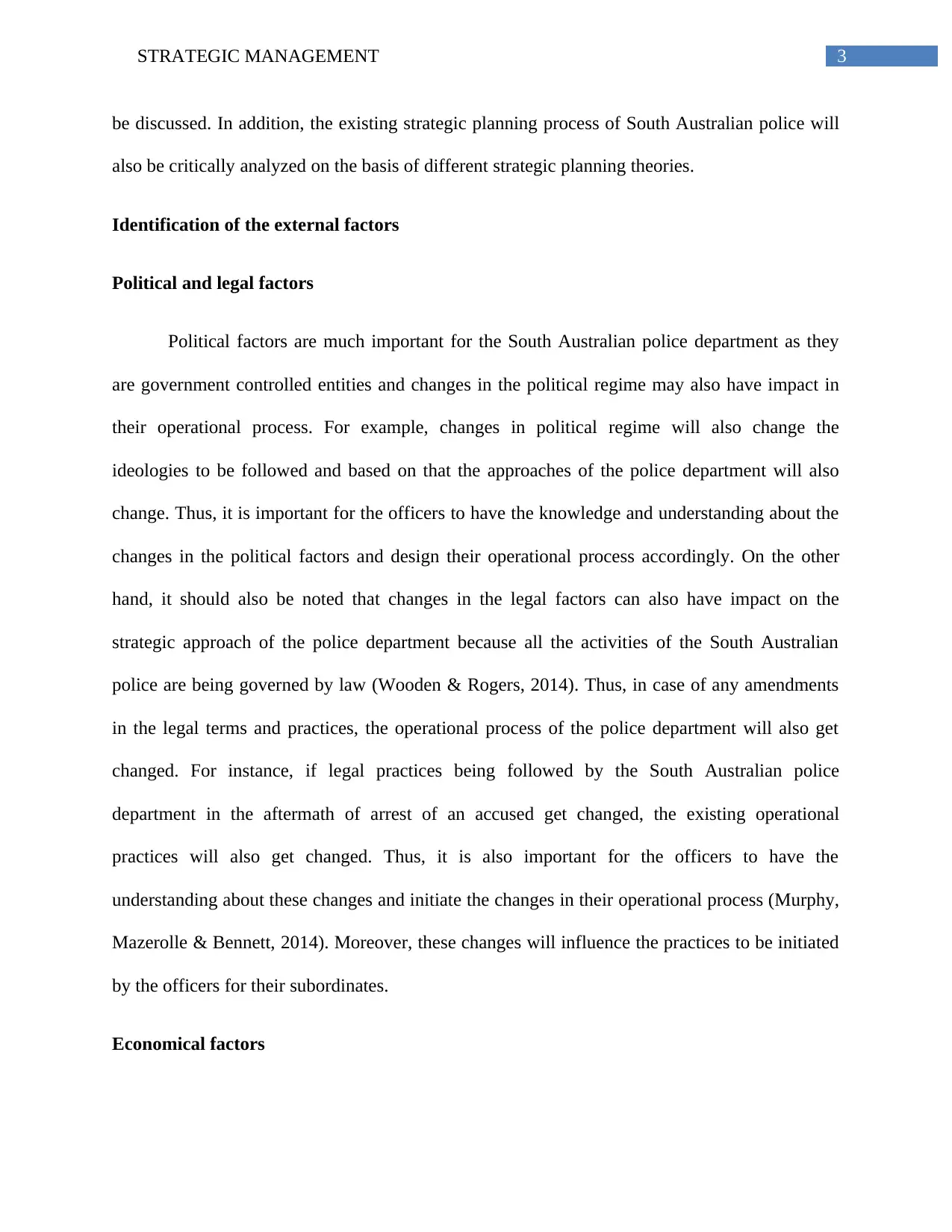
3STRATEGIC MANAGEMENT
be discussed. In addition, the existing strategic planning process of South Australian police will
also be critically analyzed on the basis of different strategic planning theories.
Identification of the external factors
Political and legal factors
Political factors are much important for the South Australian police department as they
are government controlled entities and changes in the political regime may also have impact in
their operational process. For example, changes in political regime will also change the
ideologies to be followed and based on that the approaches of the police department will also
change. Thus, it is important for the officers to have the knowledge and understanding about the
changes in the political factors and design their operational process accordingly. On the other
hand, it should also be noted that changes in the legal factors can also have impact on the
strategic approach of the police department because all the activities of the South Australian
police are being governed by law (Wooden & Rogers, 2014). Thus, in case of any amendments
in the legal terms and practices, the operational process of the police department will also get
changed. For instance, if legal practices being followed by the South Australian police
department in the aftermath of arrest of an accused get changed, the existing operational
practices will also get changed. Thus, it is also important for the officers to have the
understanding about these changes and initiate the changes in their operational process (Murphy,
Mazerolle & Bennett, 2014). Moreover, these changes will influence the practices to be initiated
by the officers for their subordinates.
Economical factors
be discussed. In addition, the existing strategic planning process of South Australian police will
also be critically analyzed on the basis of different strategic planning theories.
Identification of the external factors
Political and legal factors
Political factors are much important for the South Australian police department as they
are government controlled entities and changes in the political regime may also have impact in
their operational process. For example, changes in political regime will also change the
ideologies to be followed and based on that the approaches of the police department will also
change. Thus, it is important for the officers to have the knowledge and understanding about the
changes in the political factors and design their operational process accordingly. On the other
hand, it should also be noted that changes in the legal factors can also have impact on the
strategic approach of the police department because all the activities of the South Australian
police are being governed by law (Wooden & Rogers, 2014). Thus, in case of any amendments
in the legal terms and practices, the operational process of the police department will also get
changed. For instance, if legal practices being followed by the South Australian police
department in the aftermath of arrest of an accused get changed, the existing operational
practices will also get changed. Thus, it is also important for the officers to have the
understanding about these changes and initiate the changes in their operational process (Murphy,
Mazerolle & Bennett, 2014). Moreover, these changes will influence the practices to be initiated
by the officers for their subordinates.
Economical factors
Secure Best Marks with AI Grader
Need help grading? Try our AI Grader for instant feedback on your assignments.
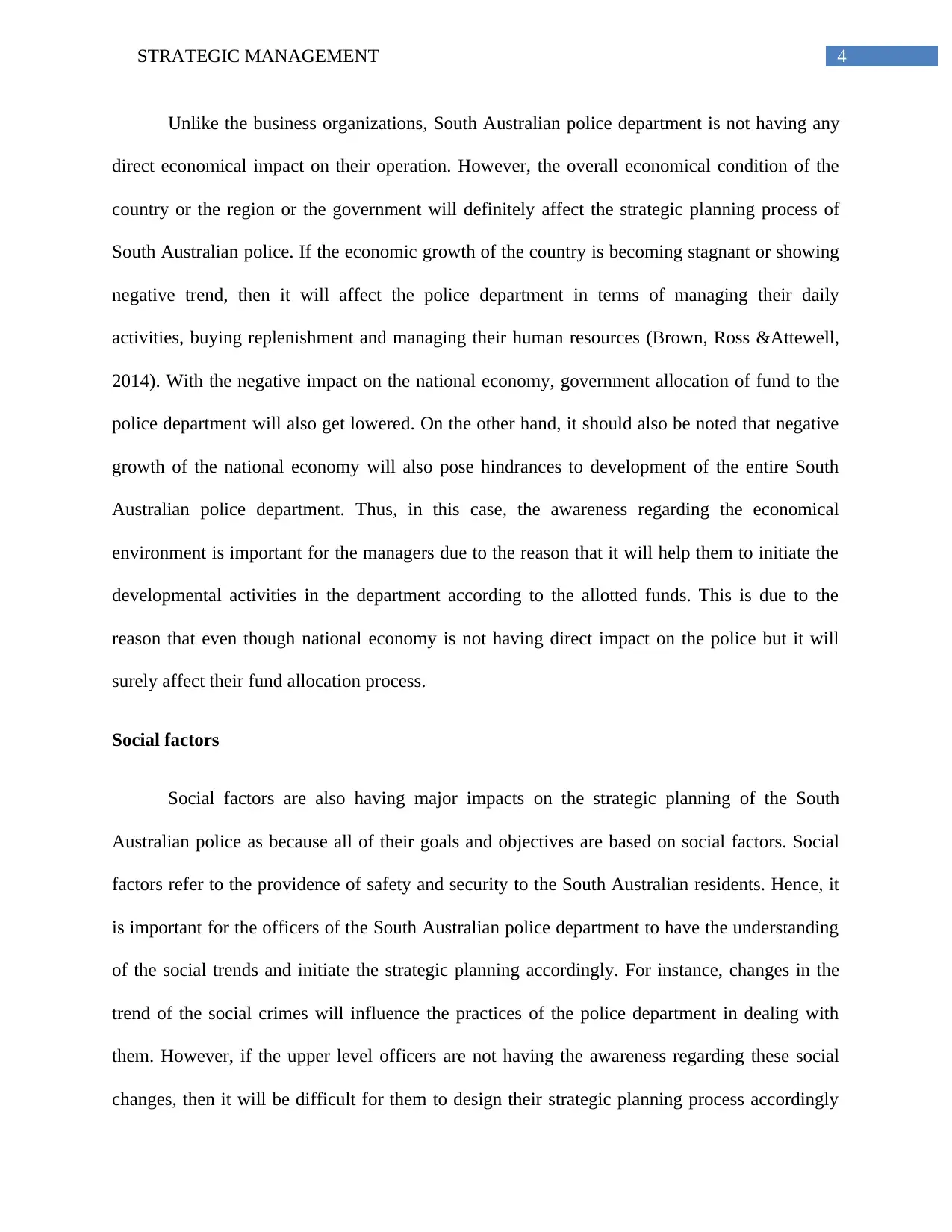
4STRATEGIC MANAGEMENT
Unlike the business organizations, South Australian police department is not having any
direct economical impact on their operation. However, the overall economical condition of the
country or the region or the government will definitely affect the strategic planning process of
South Australian police. If the economic growth of the country is becoming stagnant or showing
negative trend, then it will affect the police department in terms of managing their daily
activities, buying replenishment and managing their human resources (Brown, Ross &Attewell,
2014). With the negative impact on the national economy, government allocation of fund to the
police department will also get lowered. On the other hand, it should also be noted that negative
growth of the national economy will also pose hindrances to development of the entire South
Australian police department. Thus, in this case, the awareness regarding the economical
environment is important for the managers due to the reason that it will help them to initiate the
developmental activities in the department according to the allotted funds. This is due to the
reason that even though national economy is not having direct impact on the police but it will
surely affect their fund allocation process.
Social factors
Social factors are also having major impacts on the strategic planning of the South
Australian police as because all of their goals and objectives are based on social factors. Social
factors refer to the providence of safety and security to the South Australian residents. Hence, it
is important for the officers of the South Australian police department to have the understanding
of the social trends and initiate the strategic planning accordingly. For instance, changes in the
trend of the social crimes will influence the practices of the police department in dealing with
them. However, if the upper level officers are not having the awareness regarding these social
changes, then it will be difficult for them to design their strategic planning process accordingly
Unlike the business organizations, South Australian police department is not having any
direct economical impact on their operation. However, the overall economical condition of the
country or the region or the government will definitely affect the strategic planning process of
South Australian police. If the economic growth of the country is becoming stagnant or showing
negative trend, then it will affect the police department in terms of managing their daily
activities, buying replenishment and managing their human resources (Brown, Ross &Attewell,
2014). With the negative impact on the national economy, government allocation of fund to the
police department will also get lowered. On the other hand, it should also be noted that negative
growth of the national economy will also pose hindrances to development of the entire South
Australian police department. Thus, in this case, the awareness regarding the economical
environment is important for the managers due to the reason that it will help them to initiate the
developmental activities in the department according to the allotted funds. This is due to the
reason that even though national economy is not having direct impact on the police but it will
surely affect their fund allocation process.
Social factors
Social factors are also having major impacts on the strategic planning of the South
Australian police as because all of their goals and objectives are based on social factors. Social
factors refer to the providence of safety and security to the South Australian residents. Hence, it
is important for the officers of the South Australian police department to have the understanding
of the social trends and initiate the strategic planning accordingly. For instance, changes in the
trend of the social crimes will influence the practices of the police department in dealing with
them. However, if the upper level officers are not having the awareness regarding these social
changes, then it will be difficult for them to design their strategic planning process accordingly
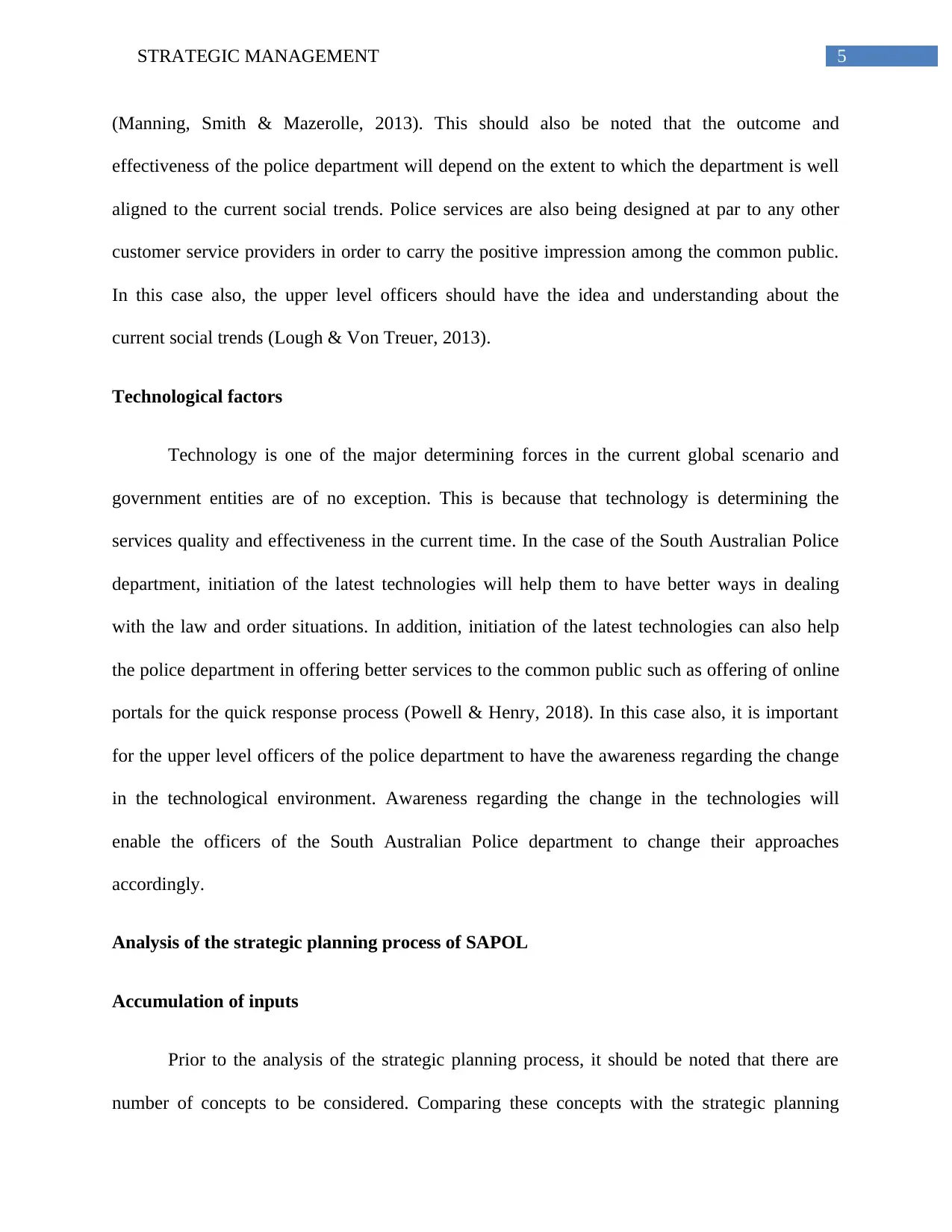
5STRATEGIC MANAGEMENT
(Manning, Smith & Mazerolle, 2013). This should also be noted that the outcome and
effectiveness of the police department will depend on the extent to which the department is well
aligned to the current social trends. Police services are also being designed at par to any other
customer service providers in order to carry the positive impression among the common public.
In this case also, the upper level officers should have the idea and understanding about the
current social trends (Lough & Von Treuer, 2013).
Technological factors
Technology is one of the major determining forces in the current global scenario and
government entities are of no exception. This is because that technology is determining the
services quality and effectiveness in the current time. In the case of the South Australian Police
department, initiation of the latest technologies will help them to have better ways in dealing
with the law and order situations. In addition, initiation of the latest technologies can also help
the police department in offering better services to the common public such as offering of online
portals for the quick response process (Powell & Henry, 2018). In this case also, it is important
for the upper level officers of the police department to have the awareness regarding the change
in the technological environment. Awareness regarding the change in the technologies will
enable the officers of the South Australian Police department to change their approaches
accordingly.
Analysis of the strategic planning process of SAPOL
Accumulation of inputs
Prior to the analysis of the strategic planning process, it should be noted that there are
number of concepts to be considered. Comparing these concepts with the strategic planning
(Manning, Smith & Mazerolle, 2013). This should also be noted that the outcome and
effectiveness of the police department will depend on the extent to which the department is well
aligned to the current social trends. Police services are also being designed at par to any other
customer service providers in order to carry the positive impression among the common public.
In this case also, the upper level officers should have the idea and understanding about the
current social trends (Lough & Von Treuer, 2013).
Technological factors
Technology is one of the major determining forces in the current global scenario and
government entities are of no exception. This is because that technology is determining the
services quality and effectiveness in the current time. In the case of the South Australian Police
department, initiation of the latest technologies will help them to have better ways in dealing
with the law and order situations. In addition, initiation of the latest technologies can also help
the police department in offering better services to the common public such as offering of online
portals for the quick response process (Powell & Henry, 2018). In this case also, it is important
for the upper level officers of the police department to have the awareness regarding the change
in the technological environment. Awareness regarding the change in the technologies will
enable the officers of the South Australian Police department to change their approaches
accordingly.
Analysis of the strategic planning process of SAPOL
Accumulation of inputs
Prior to the analysis of the strategic planning process, it should be noted that there are
number of concepts to be considered. Comparing these concepts with the strategic planning
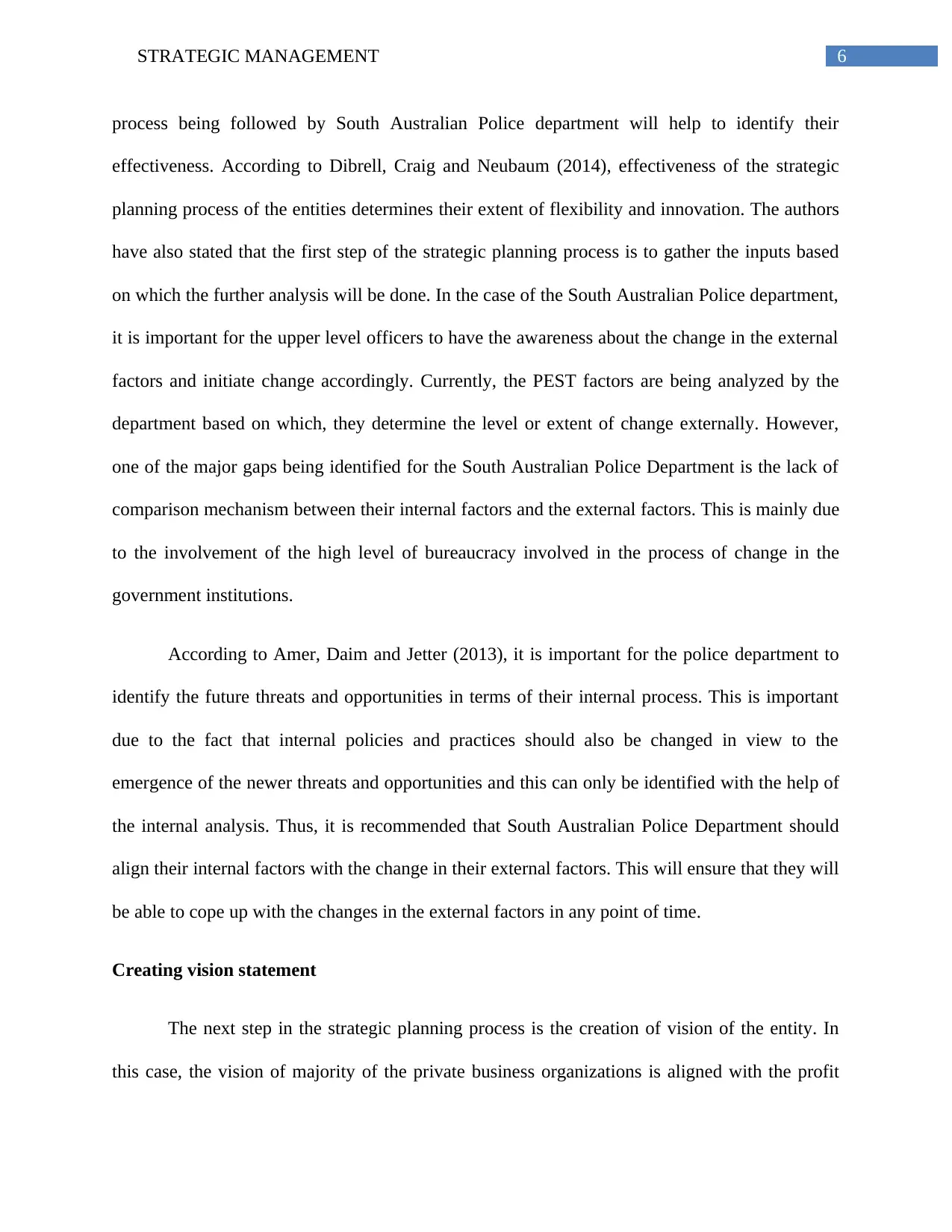
6STRATEGIC MANAGEMENT
process being followed by South Australian Police department will help to identify their
effectiveness. According to Dibrell, Craig and Neubaum (2014), effectiveness of the strategic
planning process of the entities determines their extent of flexibility and innovation. The authors
have also stated that the first step of the strategic planning process is to gather the inputs based
on which the further analysis will be done. In the case of the South Australian Police department,
it is important for the upper level officers to have the awareness about the change in the external
factors and initiate change accordingly. Currently, the PEST factors are being analyzed by the
department based on which, they determine the level or extent of change externally. However,
one of the major gaps being identified for the South Australian Police Department is the lack of
comparison mechanism between their internal factors and the external factors. This is mainly due
to the involvement of the high level of bureaucracy involved in the process of change in the
government institutions.
According to Amer, Daim and Jetter (2013), it is important for the police department to
identify the future threats and opportunities in terms of their internal process. This is important
due to the fact that internal policies and practices should also be changed in view to the
emergence of the newer threats and opportunities and this can only be identified with the help of
the internal analysis. Thus, it is recommended that South Australian Police Department should
align their internal factors with the change in their external factors. This will ensure that they will
be able to cope up with the changes in the external factors in any point of time.
Creating vision statement
The next step in the strategic planning process is the creation of vision of the entity. In
this case, the vision of majority of the private business organizations is aligned with the profit
process being followed by South Australian Police department will help to identify their
effectiveness. According to Dibrell, Craig and Neubaum (2014), effectiveness of the strategic
planning process of the entities determines their extent of flexibility and innovation. The authors
have also stated that the first step of the strategic planning process is to gather the inputs based
on which the further analysis will be done. In the case of the South Australian Police department,
it is important for the upper level officers to have the awareness about the change in the external
factors and initiate change accordingly. Currently, the PEST factors are being analyzed by the
department based on which, they determine the level or extent of change externally. However,
one of the major gaps being identified for the South Australian Police Department is the lack of
comparison mechanism between their internal factors and the external factors. This is mainly due
to the involvement of the high level of bureaucracy involved in the process of change in the
government institutions.
According to Amer, Daim and Jetter (2013), it is important for the police department to
identify the future threats and opportunities in terms of their internal process. This is important
due to the fact that internal policies and practices should also be changed in view to the
emergence of the newer threats and opportunities and this can only be identified with the help of
the internal analysis. Thus, it is recommended that South Australian Police Department should
align their internal factors with the change in their external factors. This will ensure that they will
be able to cope up with the changes in the external factors in any point of time.
Creating vision statement
The next step in the strategic planning process is the creation of vision of the entity. In
this case, the vision of majority of the private business organizations is aligned with the profit
Paraphrase This Document
Need a fresh take? Get an instant paraphrase of this document with our AI Paraphraser

7STRATEGIC MANAGEMENT
maximization. However, in the case of South Australian Police Department, their vision is to
provide the effective, visible and responsive services to the local residents of South Australia.
Thus, enhancing the social goals and objectives is the primary base of the vision statement of the
South Australian Police Department. According to Bryson (2018), internal vales and cultures
being followed are having influence on the creation of the vision statement. This is because that
cultures and values followed in the institution will determine the objectives to be gained through
creating the vision statement. However, in the case of the South Australian Police Department,
their vision statement states that majorly the external factors are being considered. Their vision
statement states the welfare of the local residents of South Australia and not how to manage the
police forces.
As per Arellano-Gault et al. (2013), it is recommended that both the internal and external
factors should be considered in the vision statement due to the reason that it will help them to
convey their long term sustainability in the region. This should be noted that South Australia
Police Department is entirely based on their human resources and the effectiveness of this human
resources will determine the efficiencies in their services. Thus, considering the organizational
values and culture being followed by them in designing the vision statement will not only create
positive image among the target audience but also it will enhance the employer branding of
them. This will convey their sustainable approach towards the society.
Creating mission designs
According to the classic 4 step approach to the strategic planning process, it is important
to determine the viability of the institutions in the society. This is due to the reason that if the
institution is not having any evident viability, then their objectives will not be fulfilled
maximization. However, in the case of South Australian Police Department, their vision is to
provide the effective, visible and responsive services to the local residents of South Australia.
Thus, enhancing the social goals and objectives is the primary base of the vision statement of the
South Australian Police Department. According to Bryson (2018), internal vales and cultures
being followed are having influence on the creation of the vision statement. This is because that
cultures and values followed in the institution will determine the objectives to be gained through
creating the vision statement. However, in the case of the South Australian Police Department,
their vision statement states that majorly the external factors are being considered. Their vision
statement states the welfare of the local residents of South Australia and not how to manage the
police forces.
As per Arellano-Gault et al. (2013), it is recommended that both the internal and external
factors should be considered in the vision statement due to the reason that it will help them to
convey their long term sustainability in the region. This should be noted that South Australia
Police Department is entirely based on their human resources and the effectiveness of this human
resources will determine the efficiencies in their services. Thus, considering the organizational
values and culture being followed by them in designing the vision statement will not only create
positive image among the target audience but also it will enhance the employer branding of
them. This will convey their sustainable approach towards the society.
Creating mission designs
According to the classic 4 step approach to the strategic planning process, it is important
to determine the viability of the institutions in the society. This is due to the reason that if the
institution is not having any evident viability, then their objectives will not be fulfilled
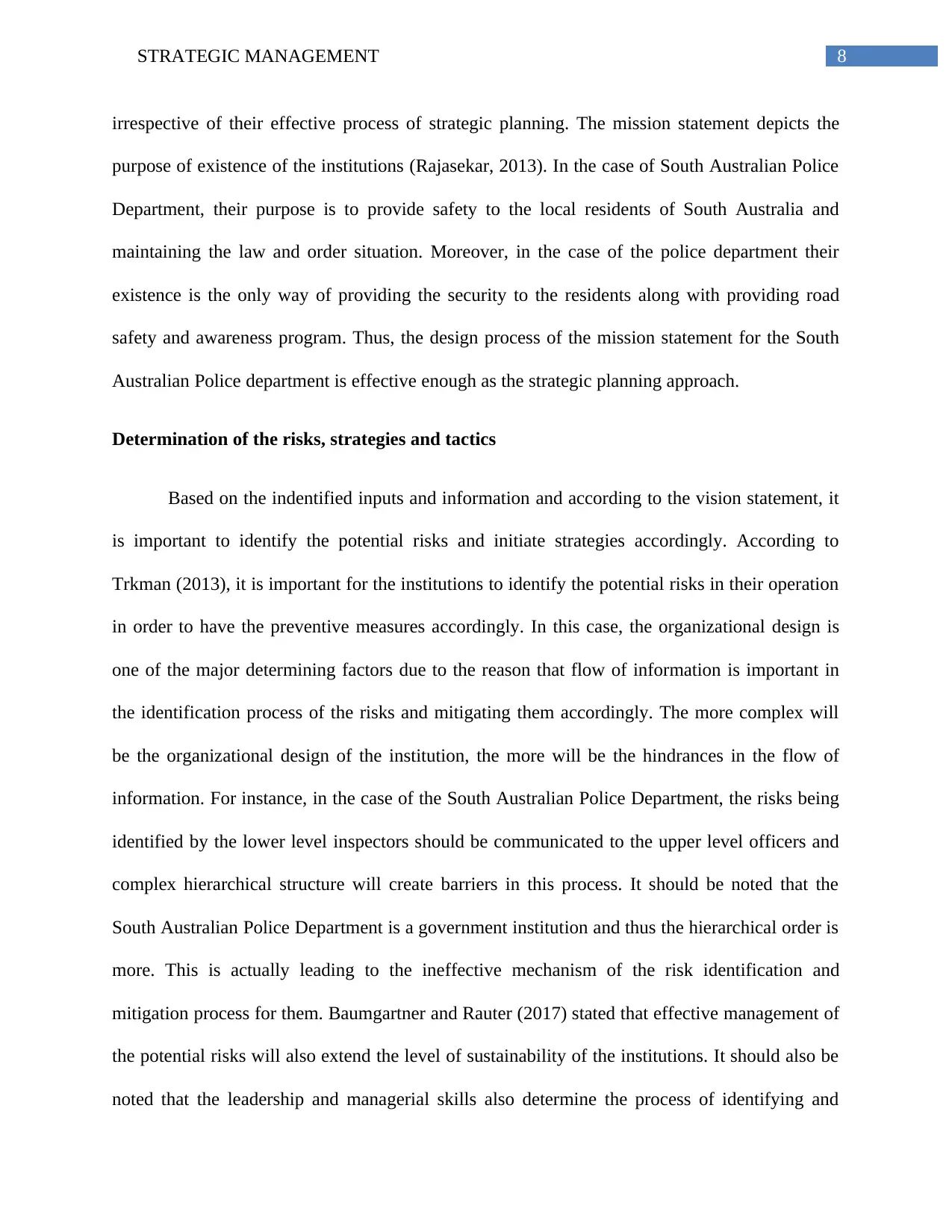
8STRATEGIC MANAGEMENT
irrespective of their effective process of strategic planning. The mission statement depicts the
purpose of existence of the institutions (Rajasekar, 2013). In the case of South Australian Police
Department, their purpose is to provide safety to the local residents of South Australia and
maintaining the law and order situation. Moreover, in the case of the police department their
existence is the only way of providing the security to the residents along with providing road
safety and awareness program. Thus, the design process of the mission statement for the South
Australian Police department is effective enough as the strategic planning approach.
Determination of the risks, strategies and tactics
Based on the indentified inputs and information and according to the vision statement, it
is important to identify the potential risks and initiate strategies accordingly. According to
Trkman (2013), it is important for the institutions to identify the potential risks in their operation
in order to have the preventive measures accordingly. In this case, the organizational design is
one of the major determining factors due to the reason that flow of information is important in
the identification process of the risks and mitigating them accordingly. The more complex will
be the organizational design of the institution, the more will be the hindrances in the flow of
information. For instance, in the case of the South Australian Police Department, the risks being
identified by the lower level inspectors should be communicated to the upper level officers and
complex hierarchical structure will create barriers in this process. It should be noted that the
South Australian Police Department is a government institution and thus the hierarchical order is
more. This is actually leading to the ineffective mechanism of the risk identification and
mitigation process for them. Baumgartner and Rauter (2017) stated that effective management of
the potential risks will also extend the level of sustainability of the institutions. It should also be
noted that the leadership and managerial skills also determine the process of identifying and
irrespective of their effective process of strategic planning. The mission statement depicts the
purpose of existence of the institutions (Rajasekar, 2013). In the case of South Australian Police
Department, their purpose is to provide safety to the local residents of South Australia and
maintaining the law and order situation. Moreover, in the case of the police department their
existence is the only way of providing the security to the residents along with providing road
safety and awareness program. Thus, the design process of the mission statement for the South
Australian Police department is effective enough as the strategic planning approach.
Determination of the risks, strategies and tactics
Based on the indentified inputs and information and according to the vision statement, it
is important to identify the potential risks and initiate strategies accordingly. According to
Trkman (2013), it is important for the institutions to identify the potential risks in their operation
in order to have the preventive measures accordingly. In this case, the organizational design is
one of the major determining factors due to the reason that flow of information is important in
the identification process of the risks and mitigating them accordingly. The more complex will
be the organizational design of the institution, the more will be the hindrances in the flow of
information. For instance, in the case of the South Australian Police Department, the risks being
identified by the lower level inspectors should be communicated to the upper level officers and
complex hierarchical structure will create barriers in this process. It should be noted that the
South Australian Police Department is a government institution and thus the hierarchical order is
more. This is actually leading to the ineffective mechanism of the risk identification and
mitigation process for them. Baumgartner and Rauter (2017) stated that effective management of
the potential risks will also extend the level of sustainability of the institutions. It should also be
noted that the leadership and managerial skills also determine the process of identifying and
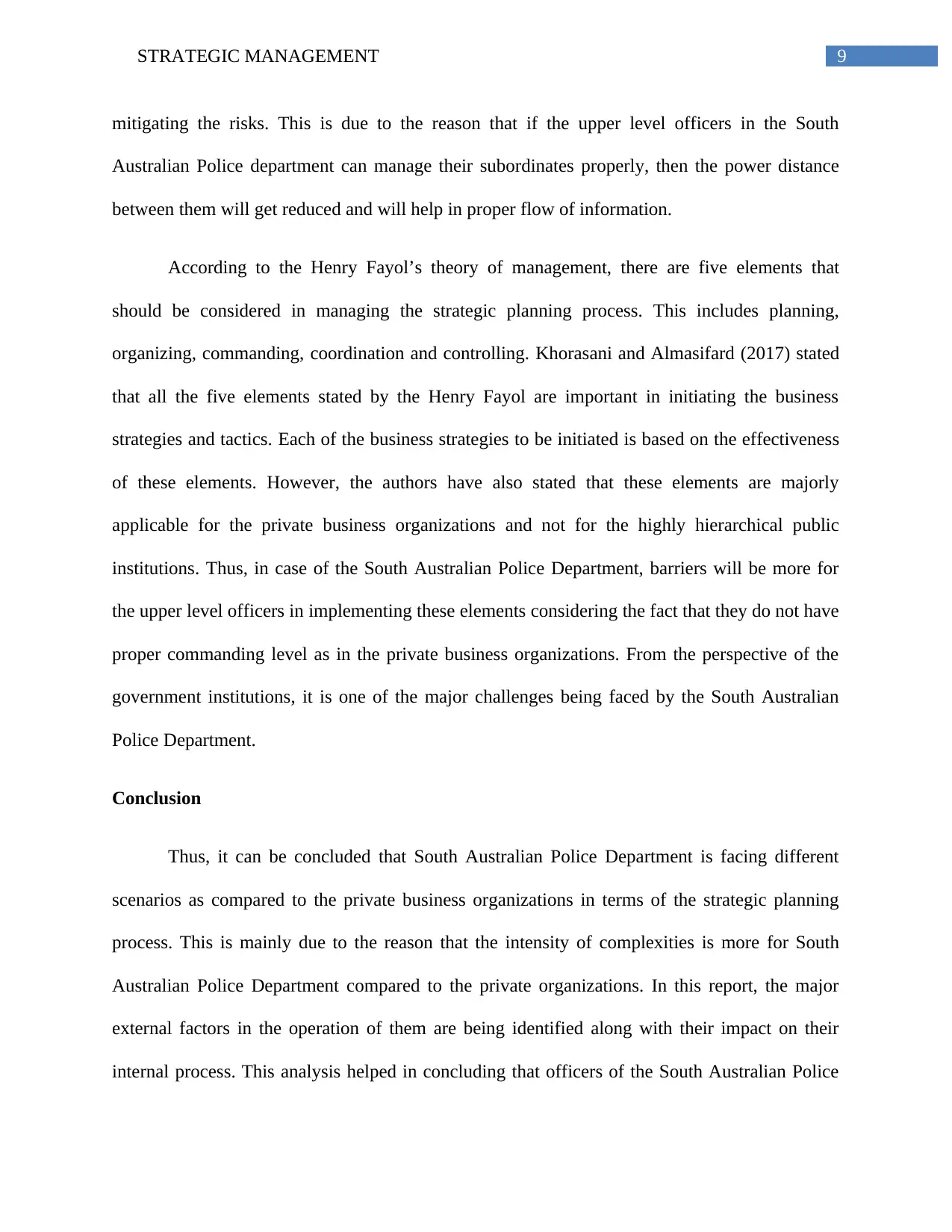
9STRATEGIC MANAGEMENT
mitigating the risks. This is due to the reason that if the upper level officers in the South
Australian Police department can manage their subordinates properly, then the power distance
between them will get reduced and will help in proper flow of information.
According to the Henry Fayol’s theory of management, there are five elements that
should be considered in managing the strategic planning process. This includes planning,
organizing, commanding, coordination and controlling. Khorasani and Almasifard (2017) stated
that all the five elements stated by the Henry Fayol are important in initiating the business
strategies and tactics. Each of the business strategies to be initiated is based on the effectiveness
of these elements. However, the authors have also stated that these elements are majorly
applicable for the private business organizations and not for the highly hierarchical public
institutions. Thus, in case of the South Australian Police Department, barriers will be more for
the upper level officers in implementing these elements considering the fact that they do not have
proper commanding level as in the private business organizations. From the perspective of the
government institutions, it is one of the major challenges being faced by the South Australian
Police Department.
Conclusion
Thus, it can be concluded that South Australian Police Department is facing different
scenarios as compared to the private business organizations in terms of the strategic planning
process. This is mainly due to the reason that the intensity of complexities is more for South
Australian Police Department compared to the private organizations. In this report, the major
external factors in the operation of them are being identified along with their impact on their
internal process. This analysis helped in concluding that officers of the South Australian Police
mitigating the risks. This is due to the reason that if the upper level officers in the South
Australian Police department can manage their subordinates properly, then the power distance
between them will get reduced and will help in proper flow of information.
According to the Henry Fayol’s theory of management, there are five elements that
should be considered in managing the strategic planning process. This includes planning,
organizing, commanding, coordination and controlling. Khorasani and Almasifard (2017) stated
that all the five elements stated by the Henry Fayol are important in initiating the business
strategies and tactics. Each of the business strategies to be initiated is based on the effectiveness
of these elements. However, the authors have also stated that these elements are majorly
applicable for the private business organizations and not for the highly hierarchical public
institutions. Thus, in case of the South Australian Police Department, barriers will be more for
the upper level officers in implementing these elements considering the fact that they do not have
proper commanding level as in the private business organizations. From the perspective of the
government institutions, it is one of the major challenges being faced by the South Australian
Police Department.
Conclusion
Thus, it can be concluded that South Australian Police Department is facing different
scenarios as compared to the private business organizations in terms of the strategic planning
process. This is mainly due to the reason that the intensity of complexities is more for South
Australian Police Department compared to the private organizations. In this report, the major
external factors in the operation of them are being identified along with their impact on their
internal process. This analysis helped in concluding that officers of the South Australian Police
Secure Best Marks with AI Grader
Need help grading? Try our AI Grader for instant feedback on your assignments.
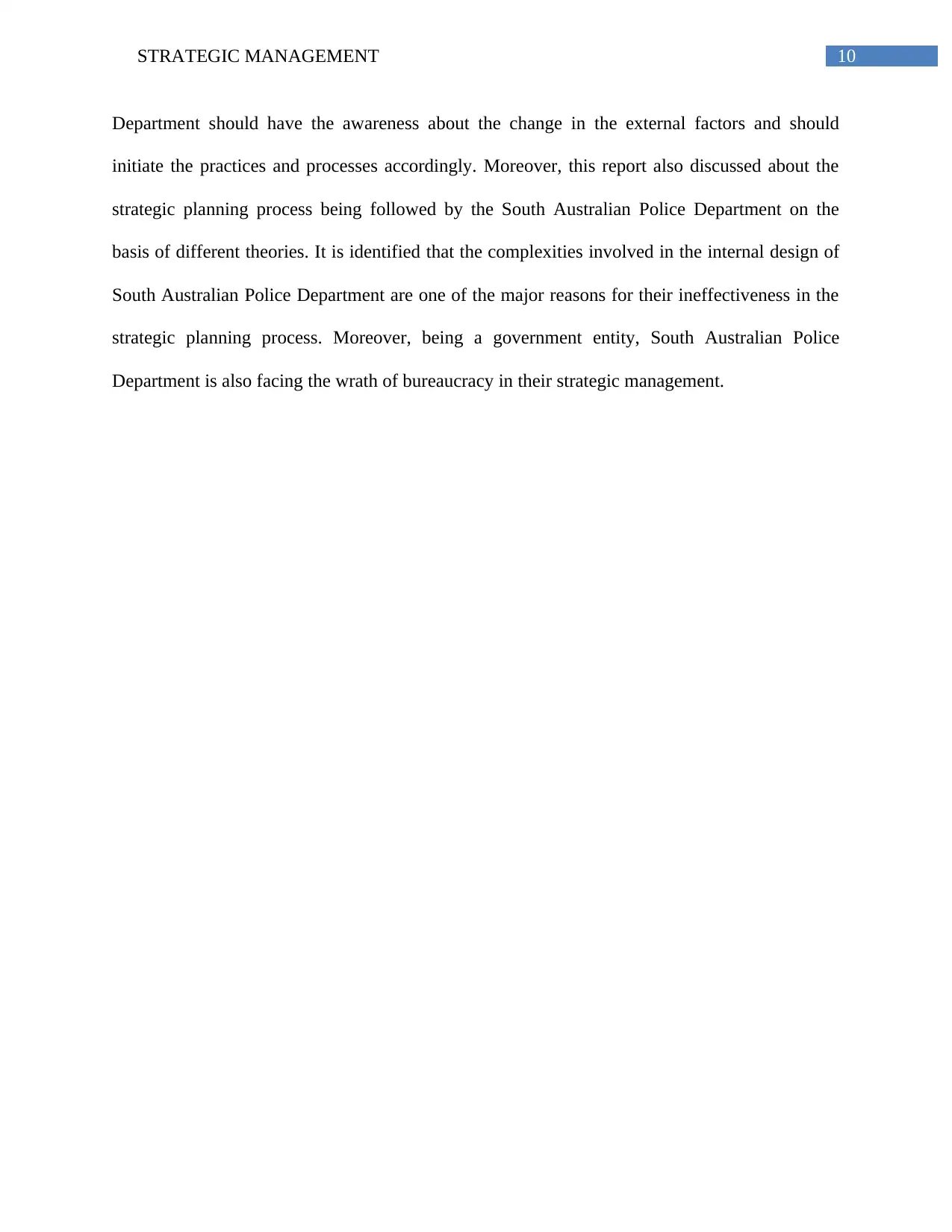
10STRATEGIC MANAGEMENT
Department should have the awareness about the change in the external factors and should
initiate the practices and processes accordingly. Moreover, this report also discussed about the
strategic planning process being followed by the South Australian Police Department on the
basis of different theories. It is identified that the complexities involved in the internal design of
South Australian Police Department are one of the major reasons for their ineffectiveness in the
strategic planning process. Moreover, being a government entity, South Australian Police
Department is also facing the wrath of bureaucracy in their strategic management.
Department should have the awareness about the change in the external factors and should
initiate the practices and processes accordingly. Moreover, this report also discussed about the
strategic planning process being followed by the South Australian Police Department on the
basis of different theories. It is identified that the complexities involved in the internal design of
South Australian Police Department are one of the major reasons for their ineffectiveness in the
strategic planning process. Moreover, being a government entity, South Australian Police
Department is also facing the wrath of bureaucracy in their strategic management.
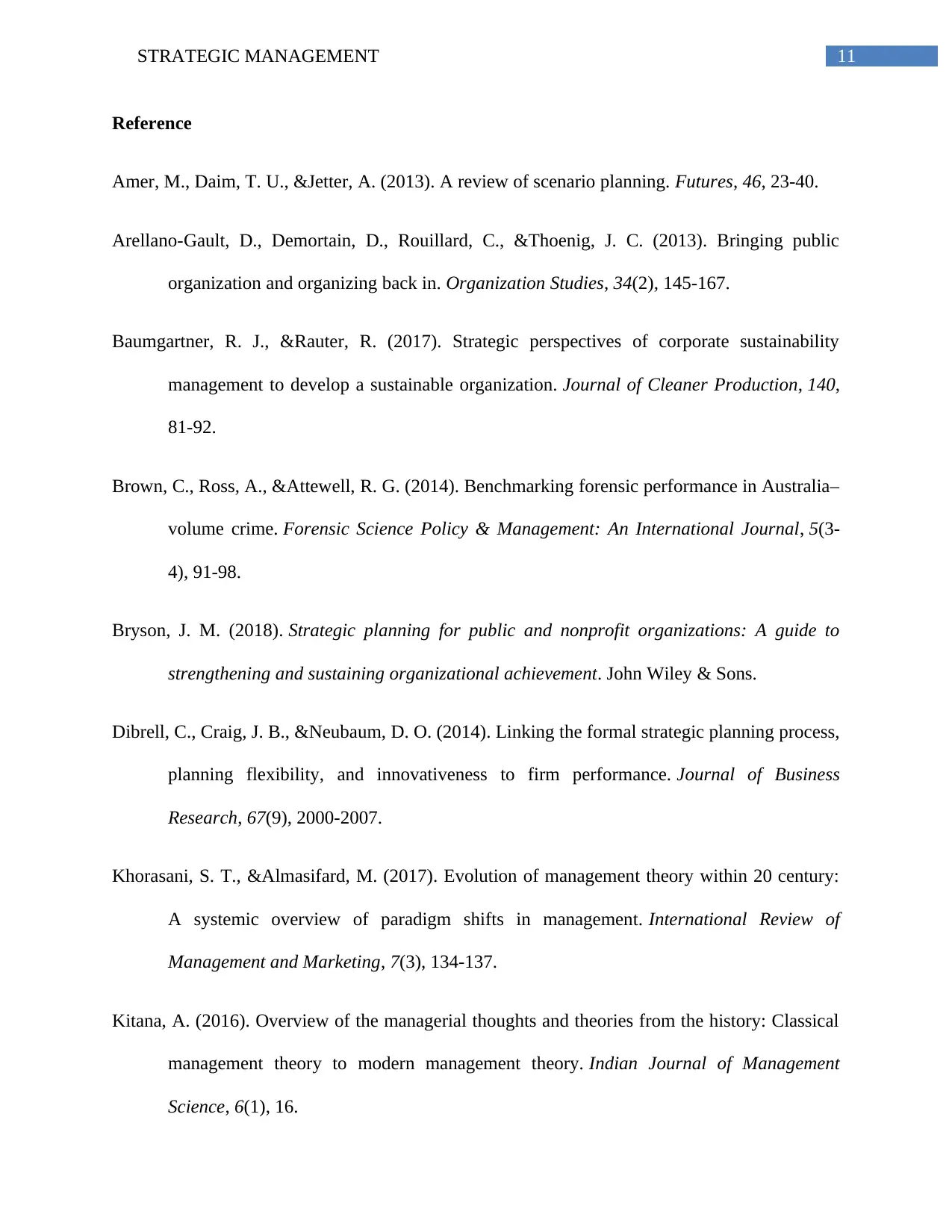
11STRATEGIC MANAGEMENT
Reference
Amer, M., Daim, T. U., &Jetter, A. (2013). A review of scenario planning. Futures, 46, 23-40.
Arellano-Gault, D., Demortain, D., Rouillard, C., &Thoenig, J. C. (2013). Bringing public
organization and organizing back in. Organization Studies, 34(2), 145-167.
Baumgartner, R. J., &Rauter, R. (2017). Strategic perspectives of corporate sustainability
management to develop a sustainable organization. Journal of Cleaner Production, 140,
81-92.
Brown, C., Ross, A., &Attewell, R. G. (2014). Benchmarking forensic performance in Australia–
volume crime. Forensic Science Policy & Management: An International Journal, 5(3-
4), 91-98.
Bryson, J. M. (2018). Strategic planning for public and nonprofit organizations: A guide to
strengthening and sustaining organizational achievement. John Wiley & Sons.
Dibrell, C., Craig, J. B., &Neubaum, D. O. (2014). Linking the formal strategic planning process,
planning flexibility, and innovativeness to firm performance. Journal of Business
Research, 67(9), 2000-2007.
Khorasani, S. T., &Almasifard, M. (2017). Evolution of management theory within 20 century:
A systemic overview of paradigm shifts in management. International Review of
Management and Marketing, 7(3), 134-137.
Kitana, A. (2016). Overview of the managerial thoughts and theories from the history: Classical
management theory to modern management theory. Indian Journal of Management
Science, 6(1), 16.
Reference
Amer, M., Daim, T. U., &Jetter, A. (2013). A review of scenario planning. Futures, 46, 23-40.
Arellano-Gault, D., Demortain, D., Rouillard, C., &Thoenig, J. C. (2013). Bringing public
organization and organizing back in. Organization Studies, 34(2), 145-167.
Baumgartner, R. J., &Rauter, R. (2017). Strategic perspectives of corporate sustainability
management to develop a sustainable organization. Journal of Cleaner Production, 140,
81-92.
Brown, C., Ross, A., &Attewell, R. G. (2014). Benchmarking forensic performance in Australia–
volume crime. Forensic Science Policy & Management: An International Journal, 5(3-
4), 91-98.
Bryson, J. M. (2018). Strategic planning for public and nonprofit organizations: A guide to
strengthening and sustaining organizational achievement. John Wiley & Sons.
Dibrell, C., Craig, J. B., &Neubaum, D. O. (2014). Linking the formal strategic planning process,
planning flexibility, and innovativeness to firm performance. Journal of Business
Research, 67(9), 2000-2007.
Khorasani, S. T., &Almasifard, M. (2017). Evolution of management theory within 20 century:
A systemic overview of paradigm shifts in management. International Review of
Management and Marketing, 7(3), 134-137.
Kitana, A. (2016). Overview of the managerial thoughts and theories from the history: Classical
management theory to modern management theory. Indian Journal of Management
Science, 6(1), 16.
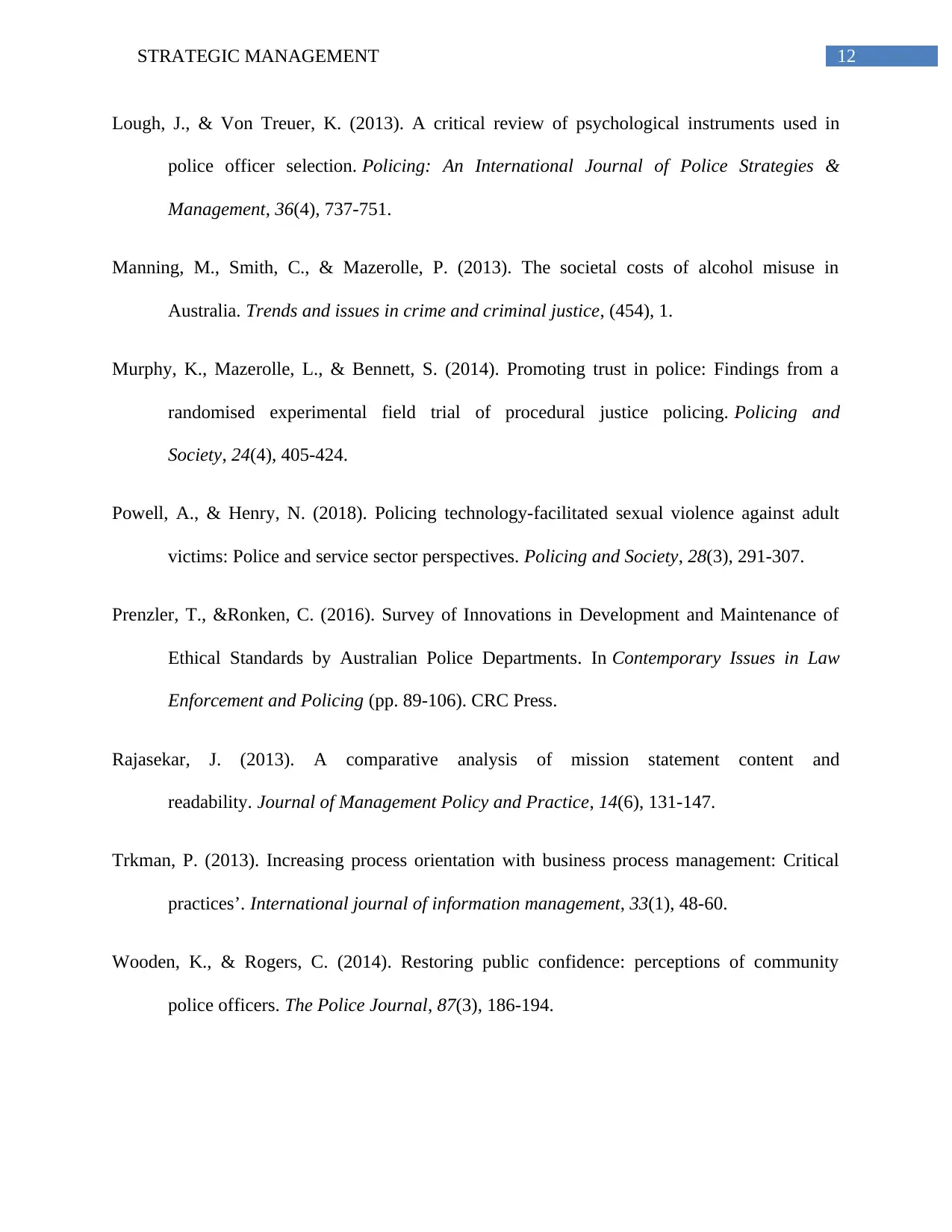
12STRATEGIC MANAGEMENT
Lough, J., & Von Treuer, K. (2013). A critical review of psychological instruments used in
police officer selection. Policing: An International Journal of Police Strategies &
Management, 36(4), 737-751.
Manning, M., Smith, C., & Mazerolle, P. (2013). The societal costs of alcohol misuse in
Australia. Trends and issues in crime and criminal justice, (454), 1.
Murphy, K., Mazerolle, L., & Bennett, S. (2014). Promoting trust in police: Findings from a
randomised experimental field trial of procedural justice policing. Policing and
Society, 24(4), 405-424.
Powell, A., & Henry, N. (2018). Policing technology-facilitated sexual violence against adult
victims: Police and service sector perspectives. Policing and Society, 28(3), 291-307.
Prenzler, T., &Ronken, C. (2016). Survey of Innovations in Development and Maintenance of
Ethical Standards by Australian Police Departments. In Contemporary Issues in Law
Enforcement and Policing (pp. 89-106). CRC Press.
Rajasekar, J. (2013). A comparative analysis of mission statement content and
readability. Journal of Management Policy and Practice, 14(6), 131-147.
Trkman, P. (2013). Increasing process orientation with business process management: Critical
practices’. International journal of information management, 33(1), 48-60.
Wooden, K., & Rogers, C. (2014). Restoring public confidence: perceptions of community
police officers. The Police Journal, 87(3), 186-194.
Lough, J., & Von Treuer, K. (2013). A critical review of psychological instruments used in
police officer selection. Policing: An International Journal of Police Strategies &
Management, 36(4), 737-751.
Manning, M., Smith, C., & Mazerolle, P. (2013). The societal costs of alcohol misuse in
Australia. Trends and issues in crime and criminal justice, (454), 1.
Murphy, K., Mazerolle, L., & Bennett, S. (2014). Promoting trust in police: Findings from a
randomised experimental field trial of procedural justice policing. Policing and
Society, 24(4), 405-424.
Powell, A., & Henry, N. (2018). Policing technology-facilitated sexual violence against adult
victims: Police and service sector perspectives. Policing and Society, 28(3), 291-307.
Prenzler, T., &Ronken, C. (2016). Survey of Innovations in Development and Maintenance of
Ethical Standards by Australian Police Departments. In Contemporary Issues in Law
Enforcement and Policing (pp. 89-106). CRC Press.
Rajasekar, J. (2013). A comparative analysis of mission statement content and
readability. Journal of Management Policy and Practice, 14(6), 131-147.
Trkman, P. (2013). Increasing process orientation with business process management: Critical
practices’. International journal of information management, 33(1), 48-60.
Wooden, K., & Rogers, C. (2014). Restoring public confidence: perceptions of community
police officers. The Police Journal, 87(3), 186-194.
1 out of 13
Related Documents
Your All-in-One AI-Powered Toolkit for Academic Success.
+13062052269
info@desklib.com
Available 24*7 on WhatsApp / Email
![[object Object]](/_next/static/media/star-bottom.7253800d.svg)
Unlock your academic potential
© 2024 | Zucol Services PVT LTD | All rights reserved.





